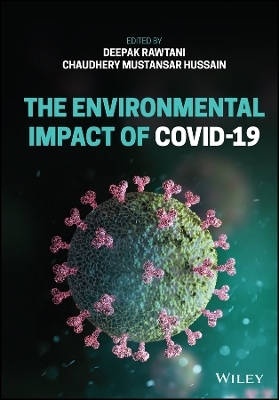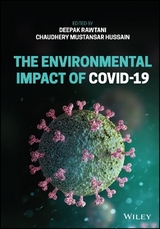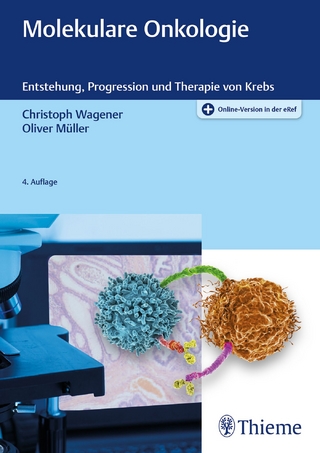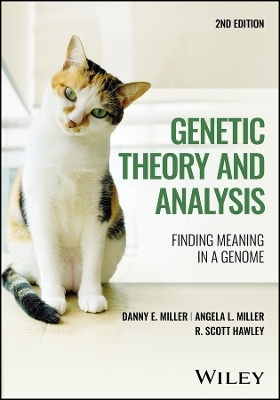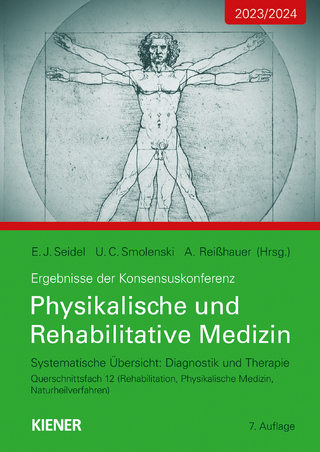The Environmental Impact of COVID-19
John Wiley & Sons Inc (Verlag)
978-1-119-77737-3 (ISBN)
Discover the wider environmental effects of the COVID-19 pandemic with this up to date resource from leading voices in the field
The Environmental Impact of COVID-19 delivers an insightful analysis of various environmental aspects of the COVID-19 pandemic that have caused global concern. The book discusses the transmission of COVID-19 in the environment, the pandemic’s environmental impact, risk mitigation and management, management of COVID-related waste, and the environmental implications of the virus.
It also considers the socio-economic implications of COVID-19’s spread, including the effects of international lockdowns on different strata of society and various industries, including the biomedical industry, the environmental industry, and the pharmaceutical industry.
An entire section of the text is devoted to a discussion about the waste generated due to COVID-19 and the effect of that waste on different environmental bodies. Another is dedicated to the impact of COVID-19 on the environment in the short- and long-term, including its effect on climate and climate change.
Readers will also benefit from the inclusion of:
- A thorough introduction to the transmission of COVID-19 in the environment, including its viability in different environmental media and the effect of environmental factors in its transmission
- An evaluation and analysis of COVID-19, including traditional analytical techniques and sampling for COVID-19 and modern sensor-based techniques for identification
- An exploration of the socio-economic implications of COVID-19, including its effect on a variety of industries
- A treatment of the environmental impact of COVID-19 in the context of risk mitigation and management
Perfect for academics and industry professionals whose work requires them to understand the wider environmental implications of the SARS-Cov-2 pandemic, »The Environmental Impact of COVID-19« will also earn a place in the libraries of private sector professionals working on products and services that aim to reduce the environmental impact of the coronavirus.
Deepak Rawtani, School of Pharmacy, National Forensic Sciences University, Gandhinagar, India.
Chaudhery Mustansar Hussain, Department of Chemistry & Environmental Sciences, New Jersey Institute of Technology (NJIT), Newark, New Jersey, USA.
Foreword xiii
1 COVID- 19: A Pandemic - Introduction 1
Pratik Kulkarni, Tejas Barot, Piyush Rao, Aayush Dey, and Deepak Rawtani
1.1 Introduction: Sources and Chemical Activities of COVID- 19 1
1.1.1 Sources and Transmission 2
1.1.2 Structure of SARS- CoV- 2 3
1.1.3 Common Symptoms, Immune Reaction to the Virus, and Mechanism of Entry 3
1.1.3.1 Immuno- evasion of Coronaviruses 4
1.1.3.2 World at Loss due to COVID- 19 5
1.1.3.3 Incubation Period 6
1.1.3.4 SARS- CoV- 2 and Basic Reproduction Number (R0) 6
1.1.3.5 Pathological Characteristics 6
1.1.3.6 Case Definitions 7
1.1.3.7 Prevention of Transmission 7
1.1.3.8 Quarantine 8
1.1.3.9 Global Response by WHO 9
1.1.4 Treatments 10
1.1.4.1 General Treatment Strategies for COVID- 19 10
1.1.4.2 Antiviral Therapy 10
1.1.4.3 COVID- 19 Convalescent Plasma for Prophylaxis 10
1.1.4.4 FDA- Approved Drug/Agents for Emergency Use Authorization (EUA) 11
1.1.4.5 Vaccines 11
1.1.5 Conclusion 12
References 12
2 Viability of COVID- 19 in Different Environmental Surfaces 19
Saeida Saadat, Piyush K. Rao, Nitasha Khatri, and Deepak Rawtani
2.1 Introduction 19
2.2 Transmission of COVID- 19 20
2.2.1 Influence of Environmental Factors on Transmission of COVID- 19 21
2.3 Survival of COVID- 19 on Different Environmental Surfaces 23
2.3.1 Survival of COVID- 19 on Households and Hospitals Surfaces 24
2.3.2 Stability of COVID- 19 in Liquid Media 25
2.4 Disinfection of the Surfaces as an Efficient Weapon Against Coronaviruses 26
2.5 Conclusion 27
References 28
3 Influence of Environmental Factors in Transmission of COVID- 19 35
Aayush Dey, Piyush K. Rao, and Deepak Rawtani
3.1 Introduction 35
3.2 Temperature, Humidity, and Transmission of COVID- 19 37
3.3 Precipitation and Its Effects on COVID- 19 Transmission 37
3.4 Food Industry and COVID- 19 Transmission 38
3.5 Water and Sewage as a Medium for COVID- 19 Transmission 39
3.6 COVID- 19 Transmission via Air 39
3.7 Transmission of COVID- 19 Through Insects 40
3.8 Personal Hygiene Amidst COVID- 19 Transmission 41
3.9 Prevalence of SARS- CoV- 2 42
3.10 Disinfection of Surfaces – SARS- CoV- 2 46
3.10.1 Suspension Tests for Surface Disinfection 46
3.10.2 Carrier Tests for Surface Disinfection 47
3.10.3 Ultraviolet (UV- C) Radiation- Mediated Disinfection of SARS- CoV- 2 47
3.11 Conclusion 50
References 51
4 Models and Strategies for Controlling the Transmission of COVID- 19 59
Yigĭtcan Sümbelli, Semra Köse, Rüstem Keçili, and Chaudhery Mustansar Hussain
4.1 Introduction 59
4.2 Routes for the Transmission of COVID- 19 60
4.3 Models for the Transmission of COVID- 19 61
4.4 Strategies for the Transmission Control of COVID- 19 62
4.5 Conclusions 64
References 64
5 Traditional Analytical Techniques and Sampling of COVID- 19 67
Aayush Dey, Piyush K. Rao, Pratik Kulkarni, and Deepak Rawtani
5.1 Introduction 67
5.2 Sample Collection from Patients 68
5.2.1 Sample Acquisition from Nose 69
5.2.2 Sample Acquisition from Saliva 69
5.2.3 Stool Sample Acquisition 70
5.2.3.1 Sample Collection from Environmental Surfaces 70
5.2.3.2 Timing of the Environmental Sample Collection 71
5.2.3.3 Environmental Sampling Methods and Procedure 71
5.2.3.4 Transport and Storage of the Samples 71
5.2.3.5 Novel Sample Collection Technique 72
5.2.3.6 Current Diagnosis for COVID- 19 72
5.2.4 Nucleic Acid Testing 73
5.2.4.1 Reverse Transcription- Based Polymerase Chain Reaction (RT- PCR) 73
5.2.4.2 Real- Time RT- PCR (rRT- PCR) 73
5.2.5 Computed Tomography 74
5.3 Conclusion 75
References 75
6 Modern Sensor- Based Techniques for Identification of COVID- 19 79
Pratik Kulkarni, Shyam Vasvani, Tejas D. Barot, Piyush K. Rao, and Aayush Dey
6.1 Introduction: Current Diagnosis for COVID- 19 79
6.2 Newer and Emerging Technologies 79
6.2.1 Isothermal Amplification Assays 80
6.2.1.1 SHERLOCK Assay 80
6.2.1.2 RT- LAMP Assay 82
6.2.2 Protein- Based Tests 82
6.2.3 Point- of- Care (POC) Testing 83
6.2.4 Aptamer- Based Assay Techniques 84
6.2.4.1 Rapid Lateral Flow Platforms Based on Aptamer Technology 85
6.2.4.2 Aptamer- Based Diagnostics of COVID- 19 in the Future 86
6.2.5 Other Novel Technologies Developed for SARS- CoV- 2 Detection 88
6.2.5.1 Localized Surface Plasmon Resonance (LSPR) Sensor 88
6.2.5.2 Field- Effect Transistor (FET) 88
6.2.5.3 Cell- Based Potentiometric Biosensor 89
6.3 Conclusion 90
References 90
7 Advanced Digital Tools for Tracing and Analysis of COVID- 19 95
Archana Singh, Aayush Dey, and Deepak Rawtani
7.1 Introduction 95
7.2 Developments in Digital Strategies for COVID- 19 96
7.2.1 Monitoring of COVID- 19 Infection 96
7.2.2 Digital Techniques in Tracing and Analysis 97
7.2.2.1 Flow Modeling Tools 98
7.2.2.2 Quarantine Compliance Tools 98
7.2.2.3 COVID- 19 Symptom Tracking Tools 99
7.2.2.4 Proximity Tracing Tools for COVID- 19 99
7.2.2.5 Contact Tracing Tool 99
7.2.2.6 Quarantine and Self- Isolation 103
7.3 Artificial Intelligence in Curbing COVID- 19 103
7.3.1 Predictive Models and Tracking of COVID- 19 via AI 104
7.3.2 AI in the Screening of COVID- 19 Cases 104
7.3.3 Pre- Diagnostics of COVID- 19 and AI 105
7.3.4 AI in Protein Structure Mapping 105
7.3.5 AI and Development of Vaccines 105
7.3.6 AI in Genomics 105
7.4 Conclusion 105
References 106
8 Challenges and Preventive Interventions in COVID- 19 Transmission through Domestic Chemistry Hygiene: A Critical Assessment 111
Kanika Sharma, Payal Kesharwani, Ankit Jain, Nishi Mody, Gunjan Sharma, Swapnil Sharma, and Chaudhery Mustansar Hussain
8.1 Introduction 111
8.2 Bioaerosolization: Ground for Transmission of SARS- CoV- 2 112
8.3 Fomites: Role in the Transmission of COVID- 19 113
8.4 Vulnerable Places for COVID- 19 114
8.5 Exposure to SARS- CoV- 2 in Aerosolized Wastewater and Dynamic from the Sanitary Plumbing System 116
8.5.1 Bioaerosol Generation by Toilet Flushing 116
8.5.2 Bioaerosol Produced During Wastewater Treatment 116
8.5.3 Bioaerosol Produced During Irrigation 116
8.6 Scientific and Technological Solution for the Hygiene of Toilet Area to Curb COVID- 19 and Other Infections 117
8.6.1 Maintaining Hygiene and Sanitation of Bathroom by Physical and Chemical Disinfection 117
8.6.2 Antimicrobial Surface 118
8.6.3 Anti- adhesive Surface 119
8.6.4 No- Contact Use for the Operation of Sanitary Facility: Sensor Technology 120
8.6.5 Inexpensive Preventive Approaches Used at Home 120
8.6.6 Technology to Detect Virus 121
8.6.7 Steps for Wastewater Management 122
8.7 Conclusive Remarks and Prospects for Future Research 122
Acknowledgments 122
Conflict of Interest 122
References 123
9 Industries and COVID- 19 127
Pratik Kulkarni, Shyam Vasvani, Tejas D. Barot, Aayush Dey, and Deepak Rawtani
9.1 Introduction 127
9.2 Renewable and Green Energy Industries 129
9.3 Agriculture Industry 130
9.4 Petroleum and Oil Industry 130
9.5 Manufacturing Industry 131
9.6 Education 131
9.7 Health Care Industry 132
9.8 Pharmaceutical Industry 132
9.9 Hospitality 133
9.10 Tourism 133
9.11 Air Travel 134
9.12 Real Estate and Housing Industry 134
9.13 Sports Industry 135
9.14 Information Technology, Media, Research and Development 135
9.15 Food Sector 136
9.16 Conclusion 137
References 138
10 Ramifications of Coronavirus on the Environment 143
Elisa Kalugendo, Manka Marycleopha, Piyush K. Rao, and Dharmesh Silajiya
10.1 Introduction 143
10.2 Footprints of Coronavirus Pandemic on the Surroundings (Mother Nature) 144
10.3 Increase in Hospital Wastes 145
10.4 COVID- 19 Declined Global Warming 146
10.5 Poor Management of Waste 146
10.6 Reset of Nature 147
10.7 Soil Contamination 148
10.8 Destruction of Arable Land 149
10.9 Increased Poaching Activity 150
10.10 COVID- 19 Resulted in the Loss of a Great Number of People 150
10.11 Negligence of Environmental Sanitation 151
10.12 Decrease of Municipal Wastewater Particles 152
10.13 Future Implications 153
References 154
11 Management of Risks Associated with COVID- 19 159
Shrutika Singla, Shruthi Subhash, and Amarnath Mishra
11.1 Introduction 159
11.2 Types 160
11.3 Origin 161
11.4 Structure 162
11.5 Risk Associated with COVID- 19 163
11.5.1 Risk at Hospitals or Point- of- Care Centers 164
11.5.2 Risk at Airport and Other Transport Mediums 165
11.5.3 Environmental Risk Due to COVID- 19 165
11.6 Risk Management and Mitigation 166
11.6.1 Gathering Information from Different Sources 166
11.6.2 Preventing National and International Traveling 166
11.6.3 Vaccination 167
11.6.4 Self- Isolation and Quarantine 167
11.6.5 Clinical Management 167
11.6.6 Masks and PPE Kits Use 167
11.7 Conclusion and Future Perspectives 168
References 168
12 Case Studies: COVID- 19 and the Environment 171
Aayush Dey, Pratik Kulkarni, Piyush K. Rao, Nitasha Khatri, and Deepak Rawtani
12.1 Introduction 171
12.2 COVID- 19 and Its Impact on the Environment – A Case Study of China 172
12.3 Environmental Impact of Particulate Matter in Italy Due to COVID- 19 173
12.4 Impact Upon the Atmospheric Environment of the Southeast Asia Region 173
12.5
Impact of COVID- 19 Lockdown on PM 10 , SO 2 , and NO 2 Concentrations in Salé City, Morocco 175
12.6 Correlation of Pandemic- Induced Lockdown and Stone Quarrying and Crushing – An Indian Perspective 175
12.7 Temperature vs. COVID- 19 Transmission – Brazil 176
12.8 Correlation of COVID- 19 and Air Quality in Spain 177
12.8.1 Conclusive Statements 177
12.9 Weather Impacts COVID- 19 Transmission – A Case Study of Turkey 178
12.10 COVID- 19 vs. Ambient Temperature – A Perspective of Canada 178
12.11 Conclusion 180
References 180
13 Effect of Waste Generated Due to COVID- 19 185
Saeida Saadat, Piyush K. Rao, Nitasha Khatri, and Deepak Rawtani
13.1 Introduction 185
13.2 Impact of COVID- 19 on Waste Production 186
13.3 Classification of Waste Generated Due to the COVID- 19 Pandemic 187
13.3.1 Domestic Waste 187
13.3.2 Biomedical Waste 189
13.4 Reduction in Waste Recycling 190
13.5 Environmental Impacts of COVID- 19 190
13.6 Management of the Generated Waste Due to the COVID- 19 Pandemic 192
13.7 Technical Approaches to Waste Management for the Post- COVID- 19 World 193
13.8 Conclusion 195
References 196
14 Strategies for Effective Waste Management for COVID- 19 203
Aayush Dey, Nitasha Khatri, Piyush K. Rao, and Deepak Rawtani
14.1 Introduction 203
14.2 Composition of Wastes Corresponding to the COVID- 19 Pandemic 204
14.3 Solid Waste 205
14.3.1 Food Wastes 205
14.3.1.1 Probable Management Strategies 206
14.3.2 Plastic Wastes 207
14.3.2.1 Plastic Waste Management Strategies 208
14.3.3 Municipal Solid Waste and Management Strategies 208
14.4 Biomedical Wastes 209
14.4.1 Hazardous Biomedical Wastes 209
14.4.1.1 Infectious Waste 209
14.4.1.2 Pathological Waste 209
14.4.1.3 Sharps Waste 211
14.4.1.4 Chemical Waste 211
14.4.1.5 Pharmaceutical Waste 211
14.4.1.6 Genotoxic Waste 211
14.4.2 Probable Mitigation Strategies for Hazardous Biomedical Wastes Generated Due to COVID- 19 211
14.4.2.1 Incineration 211
14.4.2.2 Thermal Strategies for Biomedical Waste Mitigation 212
14.4.2.3 Biomedical Waste Management- Based via Chemical Techniques 213
14.4.2.4 COVID- 19 Biomedical Waste Management via Steam Sterilization Technique 213
14.5 A Global Perspective Upon COVID- 19 Waste Management 214
14.5.1 India’s Take on COVID- 19 Waste Management 214
14.5.2 COVID- 19 Waste Management in Spain 214
14.5.3 Practices for COVID- 19 Waste Management by the United States 215
14.5.4 China’s COVID- 19 Waste Management Strategy 215
14.6 Conclusion 215
References 216
15 Environmental Policies and Strategies for COVID- 19 221
Vimbai Masiyambiri, Piyush K. Rao, Nitasha Khatri, and Deepak Rawtani
15.1 Introduction 221
15.2 Linking Policy with the Environment 222
15.3 Challenges of Creating Environmental Policy for COVID- 19 and Subsequent Pandemics 226
15.3.1 Reactive Policies 226
15.3.2 Proactive Policy Formulation for COVID- 19 227
15.3.3 Environmental Indifference, Role of Media and COVID- 19 Environmental Policy 227
15.4 Environmental Strategies for COVID- 19 228
15.4.1 Risk Analyses and Assessment of COVID- 19 229
15.4.2 Implementation of Early Warning Systems in the Environment 229
15.4.3 Post- COVID- 19 Crisis Management of the Environment 230
15.4.4 Building Infrastructure for Separation of Waste 231
15.5 Conclusion 231
References 232
16 Environmental Implications of Pandemic on Climate 235
Sapna Jain, Bhawna Yadav Lamba, Madhuben Sharma, and Sanjeev Kumar
16.1 Introduction 235
16.2 Cast Study 1: Megacities of India 236
16.2.1 Methodology 236
16.2.2 Size Description and Data Collection 236
16.3 Results and Analysis 237
16.3.1 Meteorology and Air Quality in Megacities 238
16.4 Cast Study 2: Selected Cities of Rajasthan, India 239
16.4.1 Methodology 239
16.4.2 Size Description and Data Collection 239
16.5 Result and Analysis 240
16.5.1 Meteorology and Air Quality: Case Study 2 241
16.6 Special Area of Study: Bhiwadi 241
16.7 Conclusion 242
References 243
17 COVID- 19 Pandemic: A Blessing in Disguise 245
Pratik Kulkarni, Tejas D. Barot, Piyush K. Rao, and Deepak Rawtani
17.1 Introduction: A “Make or Break” Perspective 245
17.2 How Coronavirus Is Shaping Sustainable Development 246
17.2.1 Moving Toward a Sustainable Future 248
17.2.2 Building Back Better After COVID- 19 249
17.2.3 Global Shift to Renewable Energy. Is COVID- 19 Slowing It? 250
17.2.4 Clean Energy Momentum 250
17.3 Reverting to Dirty Fuels 250
17.3.1 Part Shortages 251
17.4 Consequences of the Pandemic on Fragile States 251
17.4.1 Food Systems and the Biodiversity Connection 251
17.4.2 Mining, Conflict, and Land Rights 252
17.4.3 Prevention of Pandemic and Its Cost Measures 252
17.4.4 Prevention of New Pandemics 253
17.4.5 Climate Change and Wildlife 254
17.4.6 Necessary Responses Needed 254
17.5 Energy Security 255
17.6 Conclusion 257
References 257
Index 261
| Erscheinungsdatum | 18.03.2022 |
|---|---|
| Verlagsort | New York |
| Sprache | englisch |
| Maße | 170 x 244 mm |
| Gewicht | 652 g |
| Einbandart | gebunden |
| Themenwelt | Medizin / Pharmazie ► Medizinische Fachgebiete ► Biomedizin |
| Naturwissenschaften ► Biologie | |
| Technik ► Bauwesen | |
| Technik ► Umwelttechnik / Biotechnologie | |
| ISBN-10 | 1-119-77737-2 / 1119777372 |
| ISBN-13 | 978-1-119-77737-3 / 9781119777373 |
| Zustand | Neuware |
| Informationen gemäß Produktsicherheitsverordnung (GPSR) | |
| Haben Sie eine Frage zum Produkt? |
aus dem Bereich
